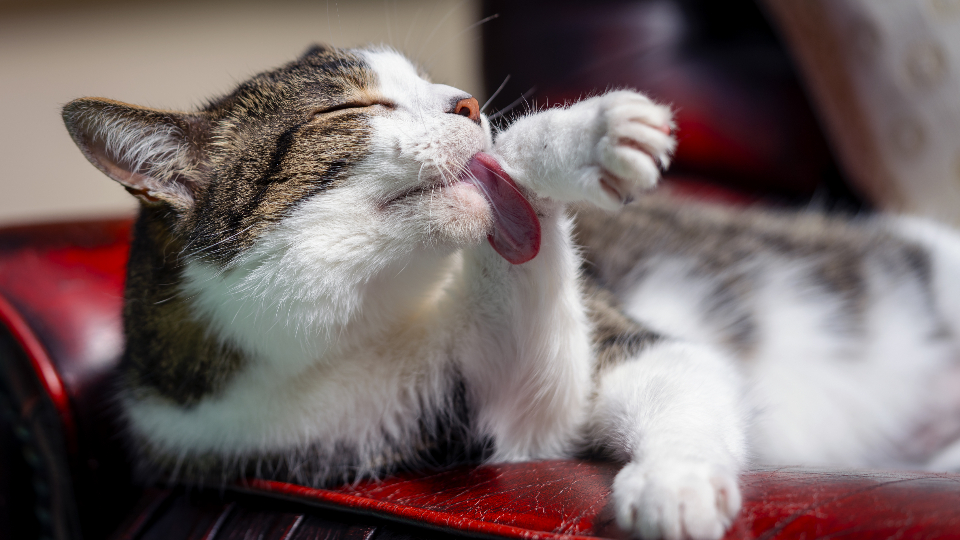Why Is My Cat Always Grooming? Overgrooming Isn’t Cute—It’s a Clue
Cats spend a significant portion of their day grooming—up to 50% of their waking hours. It’s how they stay clean, regulate body temperature, and relax. But when the licking becomes excessive, focused, or causes bald spots, it could indicate something deeper, such as stress, allergies, or an underlying medical issue. If you’ve recently found yourself thinking, “Why does my cat keep grooming herself?”—you’re not alone.
Cats groom themselves to stay clean, remove dirt and parasites, regulate body temperature, and reduce stress. But if grooming becomes constant, it may indicate allergies, skin irritation, parasites, or anxiety. If you notice your cat overgroom one spot over and over, or if your cat is licking so much that fur is disappearing, that’s a sign it’s more than just routine hygiene.
Let’s dive into the article to explore the causes, warning signs, and simple solutions. Understanding what’s normal and what’s not can make a big difference in your cat’s comfort and health.
Is It Overgrooming or Just Normal Grooming?
While regular grooming is healthy and even necessary, overgrooming is a behavior that usually focuses on a specific area and leads to visible skin issues. Normal grooming is gentle, even, and doesn’t harm the coat or skin. But if your cat is licking or chewing so much that she’s creating bald spots, scabs, or irritated patches, that’s a sign of overgrooming.
You might also notice that she seems restless, anxious, or isolates herself more than usual. These behavioral changes often go hand-in-hand with physical symptoms, and together, they point to a problem that shouldn’t be ignored.
Causes of Overgrooming in Cats
Fleas or Parasites
Even a few flea bites can make a cat intensely itchy, leading to constant licking or chewing. Cats might focus on areas like their tail base or belly, even if you don’t see live fleas. Mites and other skin parasites can cause similar irritation. If your cat is constantly licking one spot, a parasite check is a good first step.
Allergies
Cats can have allergies to certain foods, dust, pollen, or even grooming products. These allergies often show up as itchy skin, causing overgrooming in areas like the legs, belly, or neck. Trial diets or allergy testing may be needed to find the trigger. A cat overgrooming consistently may be reacting to something in its environment or diet.
Injury or Pain
When cats feel pain, especially in joints or muscles, they may lick the affected area obsessively. This behavior is common in cats with arthritis or an old injury. Since cats hide pain well, overgrooming can be the first visible clue. If your cat overgrooms a particular limb or side, it’s worth checking for discomfort.
Stress or Anxiety
Stress is a common cause of cat overgrooming. Loud noises, routine changes, moving, or new pets can all lead to anxiety. Grooming helps some cats feel calmer, but when it becomes excessive, it can cause bald spots. A cat constantly licking during stressful times may be self-soothing, much like humans bite their nails.
Boredom or Understimulation
Indoor cats, especially those without regular play or enrichment, may groom too much out of boredom. Grooming can become a repetitive behavior if there’s nothing else to do. If you’re wondering how often should cats groom themselves, several times a day is normal, but hours of licking is not. More toys, climbing spaces, and human interaction can help reduce boredom-related grooming.
Separation Anxiety
Cats closely bonded with their owners may lick more when left alone. This type of overgrooming often happens on the belly or inner thighs and may go unnoticed until hair loss appears. If your cat overgrooms mainly when you’re away, separation anxiety might be the cause. Try adding comfort items or leaving background noise to ease loneliness.
Why It’s a Problem
While it may start as a harmless habit, overgrooming can escalate quickly. Persistent licking can lead to bald spots, raw skin, painful sores, and even infections. Ingesting too much fur can also cause digestive issues, including hairballs or blockages. And in more advanced cases, the behavior can become compulsive, making it much harder to reverse.
What to Do If Your Cat Keeps Grooming Herself
If you notice your cat grooming more than usual or focusing on one area, don’t wait. Start by gently checking her skin for redness, bumps, or missing fur. Try to track when the behavior happens (after meals, when alone, during loud events), as this can help pinpoint a trigger.
How to Help Prevent and Manage Overgrooming
Once the cause is identified, managing the behavior becomes easier. Here’s how to help your cat:
1. Consult Your Veterinarian
A thorough vet exam is the first step to rule out medical causes like fleas, allergies, or joint pain. Treatment may involve medication, dietary adjustments, or parasite control based on the diagnosis. Early intervention prevents the behavior from becoming a habit.
2. Maintain a Consistent Routine
Cats are creatures of habit, and sudden changes can trigger stress-related grooming. Feed, play, and interact with your cat on a predictable schedule to reduce anxiety. Even minor routine changes, like a new feeding time, can impact sensitive cats.
3. Provide Environmental Enrichment
Bored cats often overgroom out of frustration. Add toys, window perches, and climbing trees to encourage healthy play. Rotate toys weekly to maintain novelty and engage your cat’s natural hunting instincts.
4. Use Calming Products
Pheromone diffusers like Feliway can reduce anxiety by mimicking the scent of calming facial pheromones. Spray in stress-prone areas or plug in near your cat’s favorite resting spot. These are especially helpful during transitions like moving or travel.
5. Try Nutritional Supplements
Supplements containing calming ingredients like L-theanine or casein (from milk protein) can help soothe anxiety naturally. Always consult your vet before adding anything to your cat’s diet to avoid harmful interactions or allergies.
6. Address Behavioral Issues
If grooming becomes compulsive, behavioral therapy may be needed. A veterinary behaviorist can recommend desensitization techniques or training to redirect obsessive licking. Left untreated, this can escalate into a serious self-injury issue.
7. Avoid Punishment
Scolding increases stress and may worsen the behavior. Instead, reward your cat when it engages in healthy activities like play or rest. Creating a calm, safe environment is key to breaking the overgrooming cycle.
Tip: The sooner you intervene, the easier it is to break the habit and help your cat heal—both physically and emotionally.
FAQs
How often should cats groom themselves?
Most cats groom 30–50% of their waking hours. If you’re wondering how often should cats groom themselves, that’s perfectly normal—unless it results in bald spots or skin issues.
How Much Cat Licking Is Too Much?
Most cats spend up to five hours a day grooming. If your cat suddenly starts grooming more than usual, or shows signs like bald patches, irritated skin, or frequent hairballs, it may be overgrooming. In that case, a vet visit is recommended.
Why is my cat constantly licking her belly or paws?
A cat constantly licking a specific area is often due to allergies, anxiety, fleas, or pain. Consult a vet if the behavior continues.
Can overgrooming go away on its own?
Not usually. When a cat overgrooms themselves, it’s important to identify and remove the trigger. Left untreated, the habit often worsens.
Conclusion
Grooming is part of your cat’s natural routine—but when it turns into a compulsive habit, it’s a sign that something needs your attention. Whether it’s a skin irritation, a hidden health issue, or emotional distress, excessive cat overgrooming deserves a closer look. With early action, vet support, and a few changes at home, you can help her feel more comfortable, confident, and calm again.



